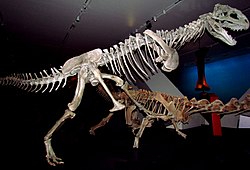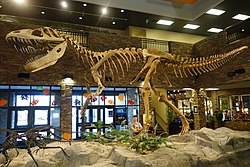| Name | Novelty | Status | Authors | Age | Unit | Location | Notes | Images |
|---|
Amplibuteo hibbardi [20] | Gen. nov. et Sp. nov. | Valid | Kenneth E. Campbell, Jr. | Late Pleistocene | Talara Tar Seeps | | An Accipitridae, this is the type species of the new genus. | |
Anas albae [21] | Sp. nov. | Valid | Dénes Jánossy | Late Pliocene | MN 15-16-17 | | An Anatidae. | |
Anas amotape [20] | Sp. nov. | Valid | Kenneth E. Campbell, Jr. | Late Pleistocene | Talara Tar Seeps | | An Anatidae. | |
Anas sanctaehelenae [20] | Sp. nov. | Valid | Kenneth E. Campbell, Jr. | Early Pleistocene; Late Pleistocene | La Carolina | | An Anatidae. | |
Anas talarae [20] | Sp. nov. | Valid | Kenneth E. Campbell, Jr. | Early Pleistocene; Late Pleistocene | Argentina: Centinale del Mar; Talara Tar Seeps | | An Anatidae, transferred to the genus Callonetta Delacour, 1936 by Agnolin, 2006. [22] | |
Ardea bennuides [23] | Sp. nov. | Valid | Ella Hoch | Subrecent | 5000 YBP (Years Before Present) | | A giant Ardeidae, not formally described but a photo is published which keeps it from being a Nomen Nudum. | |
Argillipes magnus [24] | Sp. nov. | Valid | Colin J. O. Harrison Cyril A. Walker | Early Middle Oligocene | MP 21-23 | | Described in the Catharthidae, transferred to Aves Incertae Sedis. | |
Barawertornis tedfordi [25] | Gen. nov. et Sp. nov. | Valid | Patricia Vickers-Rich | Late Oligocene/Early Miocene | Carl Creek Limestone | | A Dromornithidae, this is the type species of the new genus. | |
Belonopterus edmundi [20] | Sp. nov. | Valid | Kenneth E. Campbell, Jr. | Late Pleistocene | Talara Tar Seeps | | A Charadriidae. | |
Bubo longaevus [26] | Sp. nov. | Valid | A. S. Umanskaya | Late Miocene | MN 11-13 | | A Strigidae, transferred to the genus Asio Brisson, 1760 by Mlíkovský, 1998. [27] | |
Bullockornis planei [25] | Gen. nov. et Sp. nov. | Valid | Patricia Vickers-Rich | Middle-Late Miocene | Camfield Beds | | A Dromornithidae, this is the type species of the new genus. | |
Caprimulgus piurensis [20] | Sp. nov. | Valid | Kenneth E. Campbell, Jr. | Late Pleistocene | Talara Tar Seeps | | A Caprimulgidae-nightjar. | |
Cayaoa bruneti [28] | Gen. nov. et Sp. nov. | Valid | Eduardo P. Tonni | Late Oligocene-Miocene | | | An Anatidae. | |
Corvus simionescui [29] | Sp. nov. | Valid | Jenö Kessler | Early Pliocene | MN 15 | | A Corvidae, possibly a synonym of Corvus corone Linnaeus, 1758. | |
Cuculus csarnotanus [21] | Sp. nov. | Valid | Dénes Jánossy | Early Pliocene | MN 15 | | A Cuculidae. | |
Dege hendeyi [30] | Gen. nov. et Sp. nov. | Valid | George G. Simpson | Late Miocene-Early Pliocene | Varswater Formation | | A Spheniscidae, this is the type species of the new genus. | |
Dromornis stirtoni [25] | Sp. nov. | Valid | Patricia Vickers-Rich | Late Miocene-Early Pliocene | Alcoota Homestead | | A Dromornithidae. | |
Eudocimus peruvianus [20] | Sp. nov. | Valid | Kenneth E. Campbell, Jr. | Late Pleistocene | Talara Tar Seeps | | A Threskiornithidae. | |
Gallinago veterior [21] | Sp. nov. | Valid | Dénes Jánossy | Early Pliocene | MN 15 | | A Scolopacidae. | |
Geronogyps reliquus [20] | Gen. nov. et Sp. nov. | Valid | Kenneth E. Campbell, Jr. | Late Pleistocene | Talara Tar Seeps | | A Cathartidae. | |
Glareola neogena [31] | Sp. nov. | Valid | Peter Ballmann | Middle Miocene | MN 6 | | A Glareolidae. | |
Gymnogyps howardae [20] | Sp. nov. | Valid | Kenneth E. Campbell, Jr. | Late Pleistocene | Talara Tar Seeps | | A Cathartidae. | |
Ilbandornis? lawsoni [25] | Gen. nov. et Sp. nov. | Valid | Patricia Vickers-Rich | Late Miocene-Early Pliocene | Alcoota Homestead | | A Dromornithidae, not certainly an Ilbandornis Rich, 1979. | |
Ilbandornis woodburnei [25] | Gen. nov. et Sp. nov. | Valid | Patricia Vickers-Rich | Late Miocene-Early Pliocene | Alcoota Homestead | | A Dromornithidae, this is the type species of the new genus. | |
Latipons gardneri [32] | Gen. nov. et Sp. nov. | Valid | Colin J. O. Harrison Cyril A. Walker | Middle Eocene | MP 11-13 | | A Rallidae, this is the type species of the new genus. | |
Latipons robinsoni [32] | Sp. nov. | Valid | Colin J. O. Harrison Cyril A. Walker | Middle Eocene | MP 11-13 | | A Rallidae. | |
Litoripes medius [32] | Gen. nov. et Sp. nov. | Valid | Colin J. O. Harrison Cyril A. Walker | Middle Eocene | MP 11-13 | | Described in the Phasianidae, but transferred by Mlíkovský, 2002. [33] to Aves Incertae Sedis, this is the type species of the new genus. | |
Micropalama chapmani [20] | Sp. nov. | Valid | Kenneth E. Campbell, Jr. | Late Pleistocene | Talara Tar Seeps | | A Scolopacidae. | |
Milvago brodkorbi [20] | Gen. nov. et Sp. nov. | Valid | Kenneth E. Campbell, Jr. | Late Pleistocene | Talara Tar Seeps | | A Falconidae. | |
Milvoides kempi [32] | Gen. nov. et Sp. nov. | Valid | Colin J. O. Harrison Cyril A. Walker | Middle Eocene | MP 11-13 | | Described as an Accipitridae, known only from a damaged distal end of a right tarsometatarsus, making it not possible to identify it, better treated as Aves Incertae Sedis, this is the type species of the new genus. | |
Mioglareola gregaria [31] | Gen. nov. et Sp. nov. | Valid | Peter Ballmann | Early Miocene Czech Republic; Middle Miocene Germany | MN 4b; MN 6 | | A Glareolidae, it is the type species of the new genus. | |
Miootis compactus [34] | Gen. nov. et Sp. nov. | Valid | A. S. Umanskaya | Late Miocene | MN 13 | | An Otididae, it is the type species of the new genus. | |
Miraquila terrestris [20] | Gen. nov. et Sp. nov. | Valid | Kenneth E. Campbell, Jr. | Late Pleistocene | Talara Tar Seeps | | An Accipitridae, transferred to the genus Buteogallus Lesson, 1830 by Suárez et Olson, 2009, [35] this is the type species of the new genus. | |
Nannonetta invisitata [20] | Gen. nov. et Sp. nov. | Valid | Kenneth E. Campbell, Jr. | Late Pleistocene | Talara Tar Seeps | | An Anatidae, this is the type species of the new genus. | |
Nucleornis insolitus [36] | Gen. nov. et Sp. nov. | Valid | George G. Simpson | Miocene | Duinefontein | | A Spheniscidae, this is the type species of the new genus. | |
Nuntius solitarius [20] | Gen. nov. et Sp. nov. | Valid | Kenneth E. Campbell, Jr. | Late Pleistocene | Talara Tar Seeps | | A Scolopacidae, this is the type species of the new genus. | |
Oligocathartes olsoni [24] | Gen. nov. et Sp. nov. | Valid | Colin J. O. Harrison Cyril A. Walker | Early Middle Oligocene | MP 21-23 | | Described in the Catharthidae, but the holotype is too fragmentary for identification so best treated as Aves Incertae Sedis. | |
Palaeopapia hamsteadiensis [24] | Sp. nov. | Valid | Colin J. O. Harrison Cyril A. Walker | Early Middle Oligocene | MP 21-23 | | An Anseriformes Incertae Sedis. | |
Paracathartes howardae [37] | Gen. nov. et Sp. nov. | Valid | Colin J. O. Harrison | Early Eocene | Greybullian, Middle Wasatchian, Willwood Formation | | Described as a Cathartidae, Houde 1988 placed it in the Lithornithiformes, Houde, 1988, Lithornithidae Houde, 1988, [38] it is the type species of the new genus. | |
Paracygnopterus scotti [24] | Gen. nov. et Sp. nov. | Valid ? | Colin J. O. Harrison Cyril A. Walker | Early Middle Oligocene | MP 21-23 | | An Anatidae, it is the type species of the new genus. | |
Parvirallus gracilis [32] | Sp. nov. | Valid | Colin J. O. Harrison Cyril A. Walker | Middle Eocene | MP 11-13 | | A Rallidae. | |
Percolinus proudlocki [32] | Sp. nov. | Valid | Colin J. O. Harrison Cyril A. Walker | Middle Eocene | MP 11-13 | | Described as a Phasianidae, transferred to the genus Talantatos Reichenbach, 1852 and placed in the Cariamidae door Mlíkovský, 2002. [33] | |
Phalacrocorax tanzaniae [39] | Sp. nov. | Valid | Colin J. O. Harrison Cyril A. Walker | Early-Middle Pleistocene | Kamasian | | A Phalacrocoracidae. | |
Porzana estramosi [21] | Sp. nov. | Valid | Dénes Jánossy | Middle Miocene | MN 6-8 | | A Rallidae. | |
Proanser major [34] | Gen. nov. et Sp. nov. | Valid | A. S. Umanskaya | Late Miocene | MN 11 | | An Anatidae, it is the type species of the new genus. | |
Proardeola walkeri [40] | Gen. nov. et Sp. nov. | Valid | Colin J. O. Harrison | Early Miocene | MN 2a | | An Ardeidae, it is the type species of the new genus. | |
Proceriavis martini [24] | Gen. nov. et Sp. nov. | Valid ? | Colin J. O. Harrison Cyril A. Walker | Early Middle Oligocene | MP 21-23 | | Described as an Eleutherornithidae, based on a fragment of a cervical vertebra, best treated as Aves Incertae Sedis, it is the type species of the new genus. | |
Sarcoramphus? fisheri [20] | Sp. nov. | Valid | Kenneth E. Campbell, Jr. | Late Pleistocene | Talara Tar Seeps | | A Cathartidae, not certain to be a Sarcoramphus Duméril, 1806. | |
Scolopax baranensis [21] | Sp. nov. | Valid | Dénes Jánossy | Early Pliocene | MN 15 | | A Scolopacidae. | |
Steganopus graui [20] | Sp. nov. | Valid | Kenneth E. Campbell, Jr. | Late Pleistocene | Talara Tar Seeps | | A Phalaropodidae. | |
Syrigma sanctimartini [20] | Sp. nov. | Valid | Kenneth E. Campbell, Jr. | Late Pleistocene | Talara Tar Seeps | | An Ardeidae. | |
Theristicus wetmorei [20] | Sp. nov. | Valid | Kenneth E. Campbell, Jr. | Late Pleistocene | Talara Tar Seeps | | A Threskiornithidae. | |
Thinocorus koepckeae [20] | Sp. nov. | Valid | Kenneth E. Campbell, Jr. | Late Pleistocene | Talara Tar Seeps | | A Thinocoridae. | |
Tringa ameghini [20] | Sp. nov. | Valid | Kenneth E. Campbell, Jr. | Late Pleistocene | Talara Tar Seeps | | A Scolopacidae. | |
Turdoides borealis [21] | Sp. nov. | Valid ? | Dénes Jánossy | Early Pliocene | MN 15 | | The holotype is a heavily eroded proximal part of a left humerus, best placed in Passeriformes Incertae Sedis. | |
Valenticarbo praetermissus [41] | Gen. nov. et Sp. nov. | Valid ? | Colin J. O. Harrison | Late Pliocene | Siwalik complex | | A Phalacrocoracidae, this is the type species of the new genus. | |
Viator picis [20] | Gen. nov. et Sp. nov. | Valid | Kenneth E. Campbell, Jr. | Late Pleistocene | Talara Tar Seeps | | A Charadriidae, this is the type species of the new genus. | |
|











